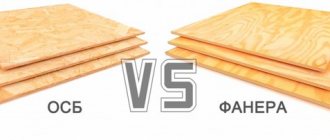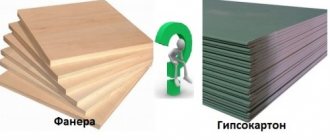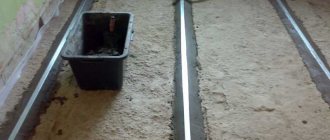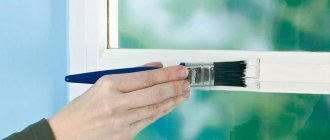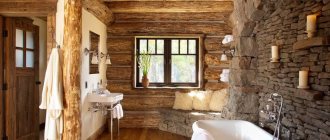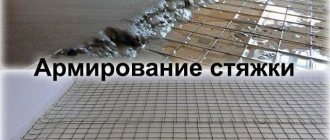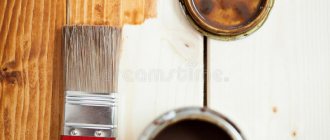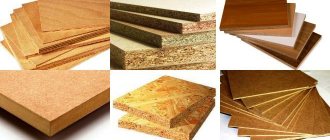The technology of building a frame house has become popular a long time ago, but today, thanks to new modern materials that extend the service life of wooden houses, new life has been breathed into the construction of frame buildings.
If previously such houses were built mainly due to lack of money, today they are a real alternative to houses made of blocks and bricks, and in some respects they are superior to such buildings.
Frame house
General characteristics of building materials for flooring
Each material used for subflooring must be durable and have good impact resistance. Four types of materials are well suited for these functions:
- Gypsum fiber sheets (GVL).
- OSB.
- Plywood.
- Chipboard.
Each material, be it plywood or OSB, has special characteristics and installation parameters. The choice of how to cover the floor in the apartment depends on this.
Technological processes in production Source chudopol.ru
For example, GVL is not used for floors with joists, since they cannot withstand such a load. Chipboard or OSB - have high strength and are used in any room. As for plywood, it is very good for laying floors with joists.
If we compare plywood, chipboard or OSB with each other - which is better for the floor in terms of environmental friendliness, then the choice falls towards natural plywood. Chipboard and OSB may exceed permissible formaldehyde standards, so when purchasing them you need to check the markings (E1, E0.5)
Both materials: plywood and OSB have common or similar properties that make them equal. It is also worth highlighting the presence of pros and cons that limit the possibility of application in specific situations.
Let's look at the characteristics of each material.
Plywood
Plywood is sheets of wood veneer, pressed and joined with specialized adhesives.
Plywood is an excellent choice for covering Source smarthomemaking.com
The wooden slab comes out whole. Sizing is carried out in at least three layers. The thickness of the plywood depends on this parameter, as well as such important characteristics as reliability, strength, and operational capabilities.
The layers are laid with perpendicular placement of wood fibers. Thanks to this structure, the building material is durable with excellent elasticity. The raw material for production is coniferous wood veneer - pine, spruce, fir, etc. Plywood made from hardwood veneer is available for sale.
Natural resins are usually used as adhesives, making the material environmentally friendly. Another option is synthetic adhesives. The latter increase the resistance of plywood in case of increased moisture.
Features of plywood:
- Building materials made with high quality natural resins are completely safe for health.
- Sheets after special treatment have a smooth surface.
- There are no tubercles.
- The plywood is perfectly sanded on one side. It is of satisfactory quality to the touch, rough, and there may be knots on the surface.
Modern GOSTs contain five classes of plywood. They differ in the number/presence of possible processing defects, as well as wood defects, and the presence or absence of synthetic components.
Plywood for coverings Source www.borisovdrev.by
Three types are usually used for laying rough and finished floors:
- FSF is a type of coating based on phenolic glue (the most durable and moisture resistant of all).
- FC is a type of plywood with a urea composition. (More environmentally friendly than the first type, but does not withstand moisture).
- FKM – melamine class plywood, waterproof.
OSB
OSB is a type of sheet that is “younger” than plywood. The building material was developed as its analogue when high-quality plywood temporarily disappeared from sale, becoming a scarce building material.
OSB is an abbreviation for the term “oriented strand board”.
OSB floor covering Source chudopol.ru
Production is carried out from wood chips, combined thanks to high pressure and resins into one durable structure. The outer chips are oriented along the sheet, and those placed inside the slab are oriented across it. OSB in this regard is very similar to plywood, consisting of a single piece of wood.
The shavings used in production are distinguished by strict dimensions: the length does not exceed 1.8 cm, the width is within 0.6-4 cm. There are materials on sale with four layers of chips. Plates with this design are resistant to the influence of various factors that differ in rigidity. The product can easily withstand loads of up to 100 kg/m3. m.
Subject to modern standards of OSB production technology, the boards are considered safe for health. The material's environmental characteristics are much better than fiberboard, MDF, and many other analogues.
Oriented strand boards of various thicknesses Source rubankom.com
Features of OSB boards:
- A homogeneous building material with a smooth surface without defects (knots and air pockets).
- The texture is similar to wood.
- The sheets have a thickness of 6-38mm.
- Many stores sell OSB in sizes 2500 x 1250mm, which is considered the most common.
- The material is used to form a level base.
- It is characterized by maximum smoothness to the touch.
In accordance with GOSTs, there are 4 classes of OSB. The boards are oriented tongue and groove, with a laminated or varnished surface.
Types of OSB are produced that can be used for work outside buildings. There are environmentally friendly, waterproof options for bedrooms and children's rooms.
Interior with OSB boards Source education-web.ru
See also: Catalog of projects of panel-frame houses and sip panels.
Pros and cons of each material
As always, there is no ideal option. Comparative characteristics of materials for a frame house are given in the table:
| Properties | MDF | Chipboard | Plywood | OSB | DSP |
| Strength | 2 | 3 | 4 | 4 | 4 |
| Climate. sustainability | 1 | 2 | 3 | 3 | 5 |
| Weight | 2 | 2 | 3 | 3 | 2 |
| Machinability | 3 | 4 | 4 | 5 | 5 |
| Paintability | 5 | 3 | 3 | 2 | 4 |
| Dimensional stability | 2 | 3 | 3 | 3 | 4 |
| Defects | 5 | 4 | 3 | 5 | 5 |
| Average score | 2,9 | 3,0 | 3,3 | 3,6 | 4,1 |
OSB or plywood for the floor, which is better?
To determine the best material, you need to familiarize yourself with the advantages and disadvantages of materials, technical characteristics and compare them.
Advantages and disadvantages of OSB and plywood
Plywood as a leveling building material has the following advantages:
- Beautiful appearance.
- If the material gets a little wet, it dries and returns to its standard form in a short time.
- Easy processing before installation.
- No tendency to deformation.
- Long-term operation without loss of characteristics.
- Through cracks do not form due to the presence of a special structure.
- Smooth surface.
The advantages of OSB boards, appreciated by craftsmen and experts:
- The cost is at an acceptable level.
- Increased resistance to humidity.
- Different sheet sizes.
- No risk of delamination.
- Strength.
- Durability.
- Wear resistance.
Leveling the floor with OSB Source ciklevka-parketa-spb24.ru
Both materials are relatively safe, environmentally friendly, and show excellent resistance to moisture and chemical influences.
But, along with the advantages, they have a number of disadvantages:
- For example, it is recommended to use plywood carefully. If you fill it with water, after drying, the process of rotting may begin.
- When cutting OSB boards, they emit a lot of dust.
- Cheap types of plywood and OSB boards emit formaldehyde during operation.
CONCLUSION
Thus, we can confidently say that from the point of view of physical and technical parameters, plywood is a more reliable material for continuous flooring under a flexible roof. While OSB-3 is a cheaper alternative. At the same time, the material is not without its advantages, which include ease of cutting and installation.
Moisture-resistant plywood
- does not delaminate when swelling
- resistant to shock loads
- holds fasteners well
OSB-3 (OSB)
- easy installation of fasteners
Video description
Watch the video for the benefits of OSB floors:
Which is better plywood or OSB board for flooring?
To understand this, you need, for example, to take 2 sheets 1cm thick - OSB class 3 and softwood veneer plywood, which is sold at a very competitive price, and compare them with each other.
Below are the characteristics of softwood plywood.
Table of specialized characteristics and properties of plywood Source userapi.com
Here are the characteristics of OSB class 3.
Table of special characteristics and properties of OSB Source userapi.com
Looking at the table below, you can easily find the differences and highlight the features of the materials.
Comparison table of OSB and plywood Source userapi.com
See also: Catalog of companies that specialize in glazing and finishing materials, including installation of floors and windows.
Before you understand what is better than OSB or plywood, you need to compare them according to technical parameters. The choice depends on humidity, various loads, and the purpose of the room in which the renovation is being carried out.
Water resistance and thermal conductivity
Building materials have virtually the same thermal conductivity.
If you look at the table, it becomes clear that OSB reacts to water more slowly than plywood, so when used in conditions of high humidity, plywood will quickly become unusable.
In rooms with high levels of moisture, it is advisable to lay OSB sheets.
Strength
The strength of any goods, regardless of category or classification, allows them to implement the tasks assigned to them. When determining the strength parameters of building materials, the result will be different.
For example, plywood made from pine needles, the FSF group, that is, on phenolic glue, is characterized by better strength than oriented strand sheets. Plywood has greater strength than OSB. Once both materials are wet, they withstand pressure differently. In this case, plywood is more stable.
Stage two: foundation
While working as a designer, most likely you have already decided on what kind of foundation you will make.
There are many options, but, as a rule, you choose from three main ones:
- tape
- columnar
- pile or pile-screw
If you are choosing a foundation for a residential frame house in which you plan to live for decades, it is better to choose a strip foundation.
If you are building a small house for a summer residence or temporary residence, you can install a lighter, columnar foundation.
If your territory has large differences, proximity to a body of water or underground rivers, it is worth considering the pile-screw option.
Strip foundation
Since the most preferred foundation for construction is a strip foundation, I will briefly tell you how it is made. First, checking the plan, we make markings.
Of course, we use pegs and rope for this. The foundation must pass under each load-bearing wall, since the walls are the main support for the roof.
When the marking is completed, we dig a trench. You can dig a trench with your own hands with a shovel, but it is much easier to order equipment for construction.
The cost of a small excavator or tractor with bucket depends on the distance, the total length of the trench and the time spent on the job.
It is better to choose several offices and call each one. The difference in price is sometimes up to 50%.
Foundation with formwork
When the trench is ready, it is necessary to install the formwork. If you don’t want to bother, you can purchase ready-made, removable or permanent formwork in the store.
If you want to save money, put it together with your own hands using boards and thick film.
When the formwork is ready, pour in the cement mixture and wait a couple of weeks for it to dry and harden.
If the weather is dry and warm, this process goes faster. If the weather is humid or it starts raining, the foundation should be covered with film.
Video description
The video provides an overview of the comparison of plywood and OSB
Environmental friendliness
It is also more environmentally friendly than its popular analogue, if you take plywood with natural resins. If we compare it with the FSF, then there is virtually no difference between them.
Two types of fabric are made with the inclusion of chemicals.
It is impossible to make an unambiguous verdict regarding the harmfulness of the presented materials.
In the manufacture of OSB, many special chemical impregnations are used, thanks to which the boards acquired their special technical characteristics. As for plywood, almost all of its samples emit formaldehyde into the environment.
Ease of use
As for the features of plywood, they are easy to cut, but they generate a lot of dust.
When cutting out an OSB element of the required size, you need to use a couple of jigsaw blades. Carrying out work with a hand saw is much more difficult.
Installation of OSB boards is easier, since they have different configurations.
As for plywood, its installation in an irregularly shaped room is fraught with great difficulties. Not to mention drilling holes for self-tapping screws and connecting the individual elements well together.
But in terms of weight, OSB boards are heavier than their analogues.
But OSB boards do not crack or delaminate.
But with plywood, deformation and shrinkage do not occur.
Cutting plywood with a jigsaw Source s.ek.ua
Do-it-yourself slabs (300 rubles per sheet)
I came up with something to replace the OSB sheet with. We take guides for drywall. They will serve as a form. You will also need film, perlite sand, cement and construction fiberglass mesh.
First we make a shape from the profile. Then we take a bucket and prepare the mixture. Mix perlite with water. 3 parts perlite, 1 part cement. Add water and mix with a mixer. Fiber fiber can be added. The mixture should look like soft plasticine (so that you can sculpt from it).
We spread the film, then lay out the mesh on the bottom of the mold, then the finished mixture. Level it with a spatula. You can make a panel 3 cm thick or less. Place a mesh on top and level it out. A solution with perlite will take a long time to dry. Do not dry in the sun. But the result is strong and light sheets (CPB is 2 times heavier).
Source
Installation features
The two materials described are an excellent rough solution for the floor. It is recommended to make the right choice taking into account operational features.
When making repairs, the best option is to use a minimum of scraps, but only whole sheets.
The process of installing slabs Source drevplity.ru
The installation work of the two types of material is actually similar. A wooden surface is an excellent base for installing parquet, laminate and other types of coatings that are installed using the floating method.
Special types of OSB boards with grooved ends are produced for linoleum for the most convenient joining of the material.
In areas with high traffic, it is advisable to install solid sheets.
Room with OSB floor Source gallery.forum-grad.ru
Where is OSB produced in Russia?
OSB boards "Kalevala" are produced by a plant located in Karelia in the city of Petrozavodsk, which is called DOK "Kalevala" LLC. This is one of the largest manufacturers of oriented strand board in Russia.
Interesting materials:
What is GoPro 8? What is a crust of bread? What are the boundaries of personal space? What is gravity 3rd grade science? What is Greek cheese? What is Grunge Girl? What is Gwe in mathematics? What do I mean I'm out? What are cells? What is a class 2 natural phenomenon?
Briefly about the main thing
There is no clear answer to the question of which is better OSB or plywood.
OSB boards and plywood, if they are not moisture resistant, are recommended to be laid in any rooms where there is no humidity. In other cases, it is still worth giving preference to moisture-resistant plywood, since under the influence of moisture, it retains its strength.
In irregularly shaped rooms, it is advisable to use OSB - the boards are sold in different configurations. But plywood is easier to cut. When the room has non-standard corners, it is recommended to use this material.
The plywood is ideally attracted to the base of the floor, thanks to which its installation is carried out as tightly as possible. But, its installation is not recommended without the use of sound insulation.
Ratings 0
Manufacturability of application
The technology for using plywood and OSB is almost the same. Sheets are cut on special machines or with hand tools. The processing of the ends of the parts is also very similar. But OSB produces more flakes when cutting with a jigsaw or a non-specialized circular saw. Therefore, to obtain a smooth edge, deeper grinding of the ends is required.
The complexity of plate processing depends on the type of plate and surface requirements. First-class sanded plywood does not require processing.
OSB does not provide such an opportunity. Therefore, plywood should be considered a more technologically advanced material. The ability to hold fasteners is equally good for these materials.
Dismantling works
When starting work on dismantling the old floor, you first need to remove the baseboard. Using a nail puller, pull out all the nails from the boards of the old floor.
Remove old boards and take them to a trash container, which must be ordered in advance. View lag status. If there is damage to the wood by rot or mold, you need to remove all the logs because the spores of wood fungus spread quickly and there is a possibility that all the old logs are affected by it.
Clean the floor and prime it with a deep penetration primer solution.
Processing of slabs for finishing
The floor is leveled, wood sheets are laid. Now we process them for finishing.
Of course, if you are satisfied with the natural pattern of the OSB, the floor can be left as is, varnished, a plinth installed, and that’s all. Or you can put any other type of finish on top. The surface of the slabs and their processing characteristics are determined by the type of finish used that will cover them.
Clean finish. Chip sheets are used in their original condition, but the surface must be protected from destruction and wear. Several layers of varnish or a special substance are applied on top to prevent the appearance of bark beetles and other insects. Linoleum or carpet.
Roll materials require a perfectly flat floor. Any differences at the joints and gaps negatively affect the operation of the linoleum, and it will not look very nice in appearance. Under the elastic carpet, cracks and other bulges from changes or screws will be felt.
It is best to cycle the floor to achieve one level. Ceramic floor tiles. The base must be stationary, especially if the sheets are laid on joists. The surface is sanded with sandpaper or a wire brush, and the tiles are placed on a special glue that connects ceramics and wood. Laminate.
This is a fairly rigid and durable material, equipped with a special fastening, so there are no special requirements for the floor. The main thing is that everything is smooth. These recommendations will help make the interior beautiful and practical, functional and durable.
Preparing old coating
Before laying pressed particle boards on the floor, it is necessary to prepare the old surface. Special equipment will help remove paint from wooden boards or even remove them if possible. The following is a process consisting of step-by-step steps:
- the old covering is removed; the floor is treated with a primer; OSB sheets are installed; reinforced with nails or self-tapping screws.
When there is a need to install a raised floor for communications, for example, in an office, then a good option is to lay OSB on a wooden floor with a pre-designed frame. Sheet flooring material is placed on top of it.
Another problem home owners face is squeaks from old floors.
Here, no matter how you level it, the sounds when walking will not go away. In order not to have to redo the repair in the future and to prevent the boards from creaking, they are nailed to the joists, each separately. The screws are twisted at an angle towards the joists.
HELPFUL INFORMATION
To understand the issues, you need to delve into the theory. The thickness of OSB and Plywood for soft roofing is usually 9 mm. Where did this figure come from, because according to roofing SNiPs, the thickness of a continuous deck with a rafter system pitch of 600 mm should be at least 12 mm, and as the rafter pitch increases, the thickness requirements increase. In practice, most roofers use a combined system: a sheathing of 25 mm thick boards is laid as the bottom layer, and sheet material is laid on top. Thus, the thickness of the flooring is even greater than required by building codes. Read more about the construction of the roofing “pie” in the article “Roof Construction”.
Source
Laying process
After completing all the preparatory work, all that remains is to tighten the slabs to the old wooden covering with self-tapping screws and fill the gap between the OSB and the wall with construction foam. After the foam has dried, it is trimmed flush with the flooring.
The slabs are fastened with self-tapping screws around the perimeter every 20–30 cm, but this distance can be reduced. Some experts recommend preparing the holes first, but using a screwdriver can quickly and efficiently tighten screws without pre-drilling.
Leveling the floor using the proposed method is the simplest, most effective and cheapest. If you follow the instructions, you can do without the help of specialists.
Preparing the base
A correctly completed preparatory stage is more than half the success of floor leveling work.
First, a thorough examination of the wooden surface is carried out. This is done using a bubble or laser level. All protruding and loose parts are marked, this will make it easier to strengthen them.
The next step is to securely fix the boards. Some experts recommend doing this using dowels, but a more reliable option would be to pull loose elements with self-tapping screws to the joists.
The old coating must be secured as securely as possible. To do this, you can use several fasteners in one area. The ideal result is when the “walking” floor fragments are recessed or are level with the rest.
Some people recommend removing the old paint layer with a sander.
You need to know that this is only necessary in areas where there are obvious blisters in the paintwork. In fact, the presence of old paint is not critical; you can lay slabs on it. In this case, it is necessary to remove all large contaminants.
Attention! The main part of the preparatory process is fixing the old wooden covering. It is this stage that should be given special attention.
Is it possible to sheathe a bathhouse and a garage inside with an OSB slab?
Garages and other outbuildings do not belong to the category of residential premises, therefore the requirements for the quality and environmental friendliness of building materials are lower. Finishing the interior walls of the garage with OSB slabs is allowed without further finishing. The requirements for the bathhouse are higher. The influence of high temperatures and humidity contributes to the destruction of OSB. As a result of temperature exposure, harmful compounds are released, so finishing the inside of bathhouses with OSB sheets is impractical. You can use them only as an element of rigidity of the frame, sheathing the building along the racks from the outside, and for interior decoration you should choose lining or imitation timber.
